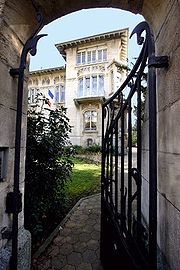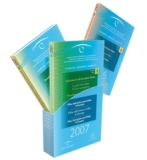
European Audiovisual Observatory
Encyclopedia
The European Audiovisual Observatory was set up by the Council of Europe
as a Partial Agreement. Its legal basis is Resolution (92) 70 of the Committee of Ministers of the Council of Europe, 15 December 1992. The idea for the Observatory originated at the European Audiovisual Assizes in 1989, and was actively pursued by Audiovisual Eureka during the years 1989 to 1992.
The observatory provides statistical and analytical information on the fields of: film, television, video/dvd, new audiovisual media services and public policy on film and television.
, France
. The budget of the European Audiovisual Observatory is mainly funded by direct contributions from its member states and the European Union
, represented by the European Commission
, and partly through revenues from the sale of its products and services.
These two departments are responsible for the collection, processing and editing of all the Observatory's information which is distributed in the form of products and services. The Observatory also hosts the secretariat of the European Platform of Regulatory Authorities (EPRA) thus allowing cooperation between the two bodies in the field of information collection. The official languages of the European Audiovisual Observatory are English
, French
and German
.
 The Observatory is housed in the famous Art Nouveau
The Observatory is housed in the famous Art Nouveau
Villa Schutzenberger in Strasbourg's 'European quarter'
. This office space is made available by the City of Strasbourg
.
Members of the European Audiovisual Observatory;
 Print Publications:
Print Publications:
Thematic reports:
Databases/Directories:
Databases/Directories
Council of Europe
The Council of Europe is an international organisation promoting co-operation between all countries of Europe in the areas of legal standards, human rights, democratic development, the rule of law and cultural co-operation...
as a Partial Agreement. Its legal basis is Resolution (92) 70 of the Committee of Ministers of the Council of Europe, 15 December 1992. The idea for the Observatory originated at the European Audiovisual Assizes in 1989, and was actively pursued by Audiovisual Eureka during the years 1989 to 1992.
The observatory provides statistical and analytical information on the fields of: film, television, video/dvd, new audiovisual media services and public policy on film and television.
Information
This information is available in the form of: Market reports, statistics and financial analyses as well as legal reports and news up-dates. The information is distributed by the Observatory in the form of products and services, some available for purchase, many free of charge: Print publications, information on-line, databases and directories, and contributions to conferences and workshops.Scope
The Observatory collects, processes and distributes information on the audiovisual sector in its member states as well as on the work of international organisations. Occasionally it also follows developments in other territories.Target Groups
The information provided by the European Audiovisual Observatory is aimed at professionals working within the audiovisual sector: producers, distributors, exhibitors, broadcasters and other media service providers, international organisations in this field, decision-makers within the various public bodies responsible for the media, national and European legislators, journalists, researchers, lawyers, investors and consultants.Statute and Resources
The European Audiovisual Observatory is based in StrasbourgStrasbourg
Strasbourg is the capital and principal city of the Alsace region in eastern France and is the official seat of the European Parliament. Located close to the border with Germany, it is the capital of the Bas-Rhin département. The city and the region of Alsace are historically German-speaking,...
, France
France
The French Republic , The French Republic , The French Republic , (commonly known as France , is a unitary semi-presidential republic in Western Europe with several overseas territories and islands located on other continents and in the Indian, Pacific, and Atlantic oceans. Metropolitan France...
. The budget of the European Audiovisual Observatory is mainly funded by direct contributions from its member states and the European Union
European Union
The European Union is an economic and political union of 27 independent member states which are located primarily in Europe. The EU traces its origins from the European Coal and Steel Community and the European Economic Community , formed by six countries in 1958...
, represented by the European Commission
European Commission
The European Commission is the executive body of the European Union. The body is responsible for proposing legislation, implementing decisions, upholding the Union's treaties and the general day-to-day running of the Union....
, and partly through revenues from the sale of its products and services.
Team
The Executive Director, Wolfgang Closs, heads a multi-cultural team from several different European countries. Structurally, the Observatory is divided into two departments: The Department for Information on Markets and Financing headed by Dr André Lange, the Department for Legal Information headed by Dr. Susanne NikoltchevThese two departments are responsible for the collection, processing and editing of all the Observatory's information which is distributed in the form of products and services. The Observatory also hosts the secretariat of the European Platform of Regulatory Authorities (EPRA) thus allowing cooperation between the two bodies in the field of information collection. The official languages of the European Audiovisual Observatory are English
English language
English is a West Germanic language that arose in the Anglo-Saxon kingdoms of England and spread into what was to become south-east Scotland under the influence of the Anglian medieval kingdom of Northumbria...
, French
French language
French is a Romance language spoken as a first language in France, the Romandy region in Switzerland, Wallonia and Brussels in Belgium, Monaco, the regions of Quebec and Acadia in Canada, and by various communities elsewhere. Second-language speakers of French are distributed throughout many parts...
and German
German language
German is a West Germanic language, related to and classified alongside English and Dutch. With an estimated 90 – 98 million native speakers, German is one of the world's major languages and is the most widely-spoken first language in the European Union....
.
Headquarters

Art Nouveau
Art Nouveau is an international philosophy and style of art, architecture and applied art—especially the decorative arts—that were most popular during 1890–1910. The name "Art Nouveau" is French for "new art"...
Villa Schutzenberger in Strasbourg's 'European quarter'
European Institutions in Strasbourg
There are a range of European Institutions in Strasbourg , the oldest of which dates back to 1815. In all, there are more than twenty different institutions based in the Alsatian city...
. This office space is made available by the City of Strasbourg
Strasbourg
Strasbourg is the capital and principal city of the Alsace region in eastern France and is the official seat of the European Parliament. Located close to the border with Germany, it is the capital of the Bas-Rhin département. The city and the region of Alsace are historically German-speaking,...
.
Network
The European Audiovisual Observatory has built up and manages a unique European information network from which it collects its information. This network is made up of:- Partner organisations and institutions
- Professional information suppliers
- Selected correspondents
Members
The European Audiovisual Observatory has 36 member states. The European Community, represented by the European Commission, is also a member. The members of the Observatory are represented on its Executive Council, which meets twice a year in order to adopt the Observatory's action plan and approve its budget. The representatives within the Executive Council usually come from those ministries and national institutions which deal with cultural or audiovisual policy.Members of the European Audiovisual Observatory;
Advisors
The Observatory's Advisory Committee is composed of representatives from the main European professional organisations as well as from the Observatory's partner organisations. It meets regularly in order to advise the Observatory on the information needs of the professionals of the audiovisual sector.Information on Markets and Financing

- The Yearbook- Film, Television and video in Europe
- FOCUS - World Film Market Trends
Thematic reports:
- Public Funding for Film and Audiovisual Works in Europe - A Comparative Approach
- Film Distribution Companies in Europe
- Television in the Russian Federation
- Video on demand in Europe
Databases/Directories:
- LUMIERE - Free-access database on admissions to films released in Europe
- KORDA - Free-access database on public funding for the film and audiovisual sector in Europe
- PERSKY - Free-access directory of television channels in Europe
- MAVISE - Database on European television companies and channels EU-27 and candidate countries (financed by the DG Communication of the European Commission)- Operational from the end of 2007
Legal Information
Publications- Iris Legal Observations - Monthly Newsletter
- Iris plus - Supplement to Iris which offers a thematic comparison of national legal systems in Europe as well as overviews of the European legal context www.obs.coe.int
- Iris Special reports on specific legal themes within the audiovisual field such as Political Debate and the Role of the Media
- Iris plus Collection which includes all articles published in the Iris plus supplement appears at the end of the year
Databases/Directories
- IRIS MERLIN - free access database on the legal audiovisual matters in Europe
- Link List - to European institutions in the audiovisual sector. Free access

